If you're exploring print for the first time, chances are you've come across both zines and magazines. Or maybe you're wondering if there's even a real difference. On the surface, they both involve pages, covers, and content. But dig deeper, and you'll find two entirely different publishing worlds.
Whether you’re a creator looking to express raw, personal ideas or a brand aiming for polished storytelling, understanding the core differences can help you choose the correct format. A zine movement is grassroots—think DIY, passion-driven, and unconcerned with mass appeal. A magazine, meanwhile, is built for scale and structure, often crafted for a specific audience with curated visuals and a professional finish.
Understanding their differences isn’t just about the words—it’s about aligning your format with your message, audience, and goals. Let’s break down the essentials of zines and magazines so you can make an informed, intentional choice.
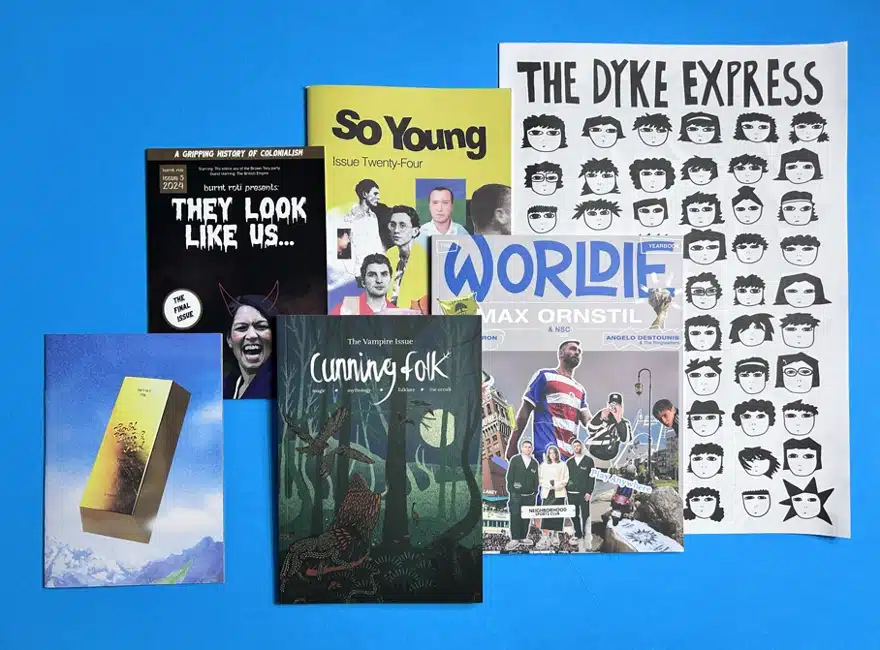
A zine is a self-published, small-batch booklet that thrives on raw creativity and zero rules.
It serves as:
You don’t need a publishing deal or design degree—just a voice and something to say.

Magazines are professionally crafted publications that follow a weekly, monthly, or quarterly schedule.
It offers:
Whether in print or digital format, magazines aim to deliver consistent, high-quality content that aligns with both their brand identity and their audience’s expectations.
If you are wondering about the difference between zines and magazines, refer to the table below for a clear explanation:
Aspect | Magazines | Zines |
|---|---|---|
Publication Type | Professionally crafted, often by companies | Self-published, DIY booklets by individuals or small groups |
Content | Curated articles, ads, and interviews | Niche topics, personal expression |
Profit-Driven | Driven by profit and advertisers | Not profit-driven, full creative freedom |
Visual Aesthetic | High-quality, polished layouts | Raw, collage-style reflecting grassroots spirit |
Digital Formats | Available in print and digital | Digital zines exist, maintaining authenticity |
Whether you’re crafting a personal zine or publishing a polished magazine, ExWhyZed offers flexible, affordable printing tailored to your project. With low minimum orders, vibrant color output, and a range of paper and binding options, we make it easy to bring your vision to life. You can count on us for reliable, high-quality prints—every time. You can request a quote today!
Zines are for anyone with something to say—raw, honest, and unfiltered. Whether it’s sharing poetry, art, personal stories, or speaking out on social issues, zines give creators complete control, with no deadlines or rules. You make one when you’re moved to speak.
From the punk scenes of the '70s to today’s digital collectives, zines have always been about connecting with like-minded folks.
You’ll find them in coffee shops, indie bookstores, zine festivals, and now all over the internet—wherever there's a need for honest, creative expression outside the mainstream.

Zines trace their roots to the amateur press movement of the late 19th and early 20th centuries. In the late 1920s, Black creators used ‘little magazines’ like Fire!! During the Harlem Renaissance, African Americans expressed themselves freely.
In the 1930s, science fiction fans began creating ‘first science fiction fanzines,' inspired by publications like Amazing Stories. The 1980s punk rock scene saw zines thrive as a DIY outlet for music, commentary, and news.
With the rise of the internet, zines transitioned from underground to global, staying true to their independent, self-expression roots while connecting communities worldwide.
Zines aren’t just small magazines—they’re raw, personal expressions of ideas often overlooked by mainstream media and current events, created in a variety of formats. Created by individuals or small groups, they offer a significant role as small press publications and a powerful medium for voices from marginalized communities, artists, activists, and anyone with alternative viewpoints or a story to tell.
From politics and punk music to mental health and identity, zines reflect honesty and creativity without filters. Personal or perzines dive into everyday struggles, offering solidarity through shared experiences. Even in a digital world, zines' handmade, tactile quality adds intimacy.
Whether exchanged at fairs or shared online, zines remain essential tools for expression, connection, and the exchange of ideas in cultural resistance.
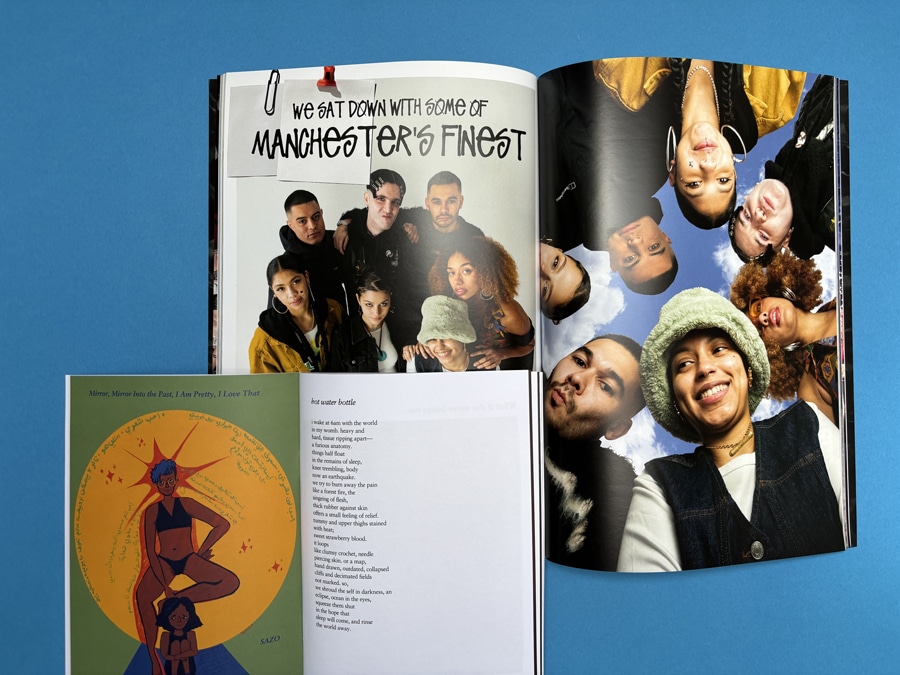
Digital zines carry forward the DIY spirit in a virtual format. Accessible, eco-friendly, and easily shared, they break geographical boundaries while preserving traditional zines' raw, personal nature.
With interactive elements like visuals, text, and motion, they offer a unique reading experience. Though the medium has shifted, the mission remains—to amplify unheard voices, spark dialogue, and build communities through creativity and authenticity.
Zines are as much about visuals as they are about words. From collages and comics to sketches and mixed media, they turn each page into a canvas for self-expression. Visual storytelling adds depth, setting mood, amplifying emotion, and often speaking louder than text.
Whether raw black-and-white art echoing punk roots or bold illustrations tackling social issues, zines use visuals to challenge, connect, and inspire.
Digital formats take this further, allowing creators to layer in GIFs, videos, and animation, expanding the zine’s power to tell bold, immersive stories that spark thought and invite dialogue.
Creating a zine is a personal and artistic journey. Start by choosing a theme—anything from personal stories to social issues or art. Then, consider the color palette, font, and layout.
Colors set the mood. Bold tones grab attention, black and white give a raw, retro edge, and soft pastels create a calm, reflective vibe. A consistent palette throughout enhances visual flow and keeps your message clear.
Fonts shape your zine’s tone. Pick ones that match your theme—quirky for fun, serif for traditional, and sans serif for modern. Ensure readability, and use size or style to show hierarchy (like titles vs. body text).
Your layout directs the reader’s experience. Short zines often use single-page designs, while longer stories benefit from multi-page spreads that allow text and visuals to breathe. You can also mix formats for variety, keeping the zine dynamic and engaging throughout.
At ExWhyZed, we understand that zines and magazines serve different creative goals—zines are raw, personal, and expressive, while magazines are polished, structured, and commercial. We offer flexible, high-quality printing solutions to match both styles.
Our HP Indigo press ensures vibrant, professional results whether you're producing 10 zines or 700 magazines. We help bring your vision to life from paper options to binding choices. And with expert support via email, phone, or live chat, you're never printing alone. Contact us now!
Zines have always been more than a medium; they are a testament to the power of independent thought and creative defiance, especially in recent years. Born out of rebellion, the punk rock movement and the riot grrrl movement have influenced punk zines, including notable examples like Rolling Stone, which continue to thrive as a raw, unfiltered platform for alternative culture and those whose voices may otherwise be silenced.
Whether crafted with paper and ink or designed digitally, zines defy convention, challenge norms, and create spaces for connection and community. Today, they are an unapologetic reflection of culture's rich history and most pressing issues—empowering creators to share their truths and spark conversation.
The zine spirit, grounded in authenticity and resistance, remains an ever-evolving force in both the analog and digital world.
While a 'zine' is derived from 'magazine', the two are significantly different. Unlike traditional magazines produced by publishing companies on a regular schedule, a zine often takes shape in an individual's hands or a small group of zine creators, published whenever the creator has something to share.
Making a zine is a creative journey that begins with an idea, often inspired by personal experiences and the rise of art, realized through a mix of text and visuals. You can use simple resources like a pen, paper, and scissors, or leverage digital tools for a polished finish, and share the finished product on social media. Free expression defines zines, promising much room for experimentation.
Digital and printed zines have each carved their niche. Digital zines cater to the rising online readership in the digital age and have more considerable distribution capabilities, but they do miss out on the tactile experience of printed zines. Nevertheless, both formats carry equal potential to convey impactful narratives.
Zines are typically self-published using DIY methods like photocopying or home printing, favoring small batches and creative freedom, including elements like graphic design. Conversely, magazines undergo professional production with professional quality and higher print quality, standardized layouts, and large-scale distribution.
Zines cater to niche audiences that resonate with their specific themes, issues, or movements. They often serve as community builders, and the Long Beach Zine Fest promotes community building among like-minded enthusiasts. On the other hand, magazines target broader audience bases, modeling their content and design to appeal to a broad spectrum of consumer interests.
An informative 5 minute read.
At Ex Why Zed, we understand that printing a zine is more than just producing a publication—it’s about bringing a creative vision to life with precision, quality, and a deep understanding of the message it conveys. Zines are unique, personal expressions of art, culture, identity, and activism. Whether you’re aiming to self-publish a zine, create a perfect bound zine, or produce an eye-catching stapled zine, we are here to guide you through the journey, from the first spark of creativity to the final printed masterpiece. Our expertise lies not just in the technical aspects of zine printing, but also in helping creators preserve the essence of their vision, ensuring it resonates through every page.
To help you make informed print choices when you self-publish a zine, we’ve analysed and dissected a series of recent zine printing projects that highlight how different binding methods, paper choices, and design considerations come together to create exceptional zines. Whether you are producing an A5 zine, exploring perfect binding for a polished finish, or opting for a stapled zine for a raw, DIY feel, the following case studies will offer valuable insights into how you can elevate your zine with thoughtful, expert printing. From bold political statements to dynamic art and music explorations, each project reveals the creative potential of zine printing and how Ex Why Zed brings these ideas to life with care and craftsmanship.
Let’s dive into the journey of these incredible zines and discover how we helped each project achieve its unique impact through expert printing solutions.

The journey with Burnt Roti Issue 5 was a testament to the power of zine printing in delivering a bold, unflinching narrative. This zine tackles complex issues surrounding British-Asian identity politics, combining fierce political commentary with striking design elements. The cover alone—a vivid, provocative illustration featuring prominent political figures—sets the tone, while the choice of perfect bound zine ensures that the publication has a durable, professional finish while staying true to its rebellious spirit.
From the matte lamination on the cover to the 115gsm silk inner pages, Burnt Roti Issue 5 offers a tactile contrast that enhances the experience. The distressed typography and high-quality full-colour illustrations speak volumes about the zine’s theme of defiance against the status quo. The perfect binding method, paired with Ex Why Zed’s precision in colour printing, allowed for a premium finish that didn’t dilute the raw energy of its content. This project highlights how thoughtful paper and binding choices—coupled with technical advice and collaborative spirit—bring out the zine’s full potential.
Read the full Burnt Roti Issue 5 Zine case study here ›

When So Young Magazine reached its 50th issue, Ex Why Zed was there to support them in producing a staple bound zine that not only celebrated the magazine’s milestone but also showcased the energy and vibrancy of the independent music scene. Featuring dynamic photography, bold typography, and an eclectic mix of artists, this issue was designed to resonate with music lovers and culture enthusiasts alike.
The custom 245x172mm zine format combined with staple binding made this publication both compact and substantial, inviting readers to experience its content up close while maintaining a sleek, professional look. The use of full-colour images, interspersed with vivid neon hues and typography, perfectly captured the magazine’s essence. By advising on cost-effective paper types and ensuring the content maintained visual consistency, Ex Why Zed helped So Young Magazine deliver a publication that truly stands out in the world of music journalism.
Read the full So Young Issue 50 Zine study here ›

For Cunning Folk Magazine, a publication that blends mystical and folklore-inspired content, the challenge was not only the tight turnaround time but also the need for precision and consistent quality. This 240x170mm zine, produced on FSC-certified paper, needed a professional perfect zine format that would offer both durability and a tactile, portable experience for readers. The use of litho printing for this long-run project ensured cost-effectiveness and gave zine an uncompromising premium look.
Ex Why Zed’s customer-focused approach, along with guidance on digital versus litho printing for a print run of 1200 copies, ensured that Cunning Folk Magazine was produced quickly and effectively. The tactile uncoated paper stock and perfect binding gave the magazine the feel of quality printing, ensuring every page—whether filled with detailed illustrations or insightful text—was printed to perfection.
Read the full Cunning Folk creative writing zine case study here ›

Shooter Issue 17, a literary journal exploring 'The Unknown', exemplifies how design and content work together to elevate the narrative. Produced with perfect binding and using a premium 120gsm uncoated stock for inner pages, this perfect bound zine seamlessly combined the elegance of poetry with the raw power of visual art. The design choice of pastel greens as a bed for the minimalist typographic choices reinforced the theme of exploration while keeping the visual narrative clean and readable.
At Ex Why Zed, we worked with the editor to navigate technical challenges, from adjusting images for print to ensuring that each page of Shooter Issue 17 felt cohesive with the zine’s artistic vision. The perfect binding method not only preserved the tactile quality of the zine but also elevated its status as a collectible piece. The seamless integration of design and content showcased Ex Why Zed’s ability to handle intricate creative projects with expertise and precision.
Read the full Shooter Issue 17 case study here ›

Tyler Dolph’s In A Flash, a zine that captures the fervor of Columbus Crew FC’s passionate fans, is an excellent example of how the A5 zine format can bring to life a dynamic, high-energy project. The perfect binding technique used for this project ensured that each page—a stunning collection of full-colour images and bold typography—was beautifully presented and durable enough to withstand heavy handling by fans.
By using smooth silk paper and providing guidance on high-quality full-colour printing, Ex Why Zed helped Tyler create a publication that was as much a collectible piece of art as it was a celebration of sport. The A5 zine format was perfect for this type of project, offering just the right balance between portability and visual impact.
Read our perfect bound photography zine case study ›

Meat Magazine 8 is a prime example of how stapled zines can be used to create visually impactful publications that reflect a unique and raw aesthetic. Printed on recycled paper stock with the cover onto a bespoke kraft-style sheet, the magazine aligns with eco-conscious values while presenting cutting-edge design. The stapled binding allows the zine to maintain its zine-like quality while still offering a professional presentation that engages readers through its bold typography and experimental layouts.

Ex Why Zed's expertise in choosing the right materials for the project—FSC-certified recycled stock—ensured that Meat Magazine 8 not only delivered visually but also aligned with sustainable publishing practices. The stapled zine format offered the perfect solution for an indie publication that needed to reflect its DIY roots while maintaining high print standards.
Nominated for a Guardian award speaks volumes about the design, content and styling prowess.
Read the case study of the first zine we ever printed ›

A-Z Lookbook 24 by Zeros Art blends the worlds of pop culture and artistic illustration in a stunning A5 zine format. The perfect binding and use of FSC-certified silk paper ensured that the finished product was both luxurious and tactile. The bright and contrasting colours of the illustrations jump off the pages, while the minimalist typography ensures the art takes centre stage.

Ex Why Zed's input in choosing the right paper stock and providing expert guidance on print quality ensured that every detail—from the vivid colours to the crispness of the typography—was faithfully rendered. This perfect bound zine showcases how powerful design and quality production come together to elevate a creative vision.
Enjoy the case study of our creative industry zine printing ›

Phantasmag Issue 1—a B5 zine that merges horror, music, and art—was printed with precision to reflect its bold and evocative content. The perfect binding of this 250x176mm zine allowed for a professional finish that didn’t compromise the raw energy of the design. The restrained use of colour, with black-and-white illustrations punctuated by flashes of pink, sets the tone for this dark exploration of horror culture.
The collaboration between Ex Why Zed and Phantasmag ensured that the technical aspects—colour conversion, paper choices, and layout adjustments—were all executed seamlessly, resulting in a visually cohesive publication that aligned with the zine’s unique themes.
Read the perfect bound zine printing case study here ›

Peak Magazine Issue 4 pushes the boundaries of traditional zine design with its oversized A3 format, making it an immersive publication that highlights urban and natural landscapes with stunning visuals. The unbound, nested format enhances the tactile experience, inviting readers to fully engage with the content. The use of vibrant hues, combined with sleek typography and spacious layouts, creates a perfect balance between the text and images. The dynamic layouts, full-page spreads, and bold imagery allow each spread to breathe, while still guiding the reader through the magazine’s visual narrative. The oversized format elevates the storytelling, enabling readers to fully appreciate the detailed photography that captures the urban grit and natural beauty featured throughout.

Read the case study of this impressive A3 zine here ›

Still Listening Issue 9 combines dynamic design with a celebration of emerging music talent. The zine's experimental approach to typography and its juxtaposition of bold, full-bleed images with clean body text creates a visually engaging experience. With two alternate covers and a strong sense of individuality, this project highlights how A5 zines can reflect the energy of music and subcultures while still maintaining a clear visual identity. The uncoated paper stock adds a tactile dimension to the zine, creating a matte finish that allows the vibrant illustrations and images to shine. The design choices—ranging from bright colour contrasts to a minimalist layout—capture the raw energy of the indie music scene, making it both a collector's piece and a visual feast.
The typography in Still Listening Issue 9 is a standout feature, with its mix of bold sans-serif headings and playful script fonts. The script on the cover adds a personal, handwritten touch, enhancing the indie zine vibe while maintaining readability. Inside, the careful balance between large images and white space ensures that the zine doesn’t overwhelm the reader, despite its bold design. This interplay between text and imagery invites the reader to slow down and fully absorb the content, whether it’s an interview with an emerging artist or a feature on a new music genre. The A5 zine format complements this design, making it both portable and visually compelling—perfect for music enthusiasts and zine collectors alike.
Read our music zine printing case study here ›

The Worldie 23/24 Lookbook is a visual celebration of artistic expression and football culture. The perfect binding in this A5 zine format elevated the experience, providing a sleek and professional finish while still capturing the vibrant energy of the street football community. The use of vivid colours, combined with sharp typography, helped to make this publication an immersive journey into the style and spirit of Worldie FC. The mix of street fashion photography and dynamic graphic design embodies the fluid, energetic world of football culture, offering a bold contrast between athleticism and style. Each page is carefully designed to draw attention, making the lookbook as much about the art of football as it is about fashion.

Beyond the visuals, Worldie 23/24 Lookbook conveys a deep sense of community and inclusivity, which is reflected in both the design and content. The interplay between full-colour spreads and minimalist text gives the publication a unique rhythm, allowing the reader to be absorbed in both the visuals and the stories. The decision to use FSC-certified materials reinforces the brand’s eco-conscious stance, aligning with the values of sustainability in football culture. The A5 zine format complements the need for a publication that’s accessible, portable, and packed with punch, making it a perfect blend of style, art, and activism.
Read the perfect bound zine case study here ›

The Dyke Express is unapologetic, loud, and proud—just like its message. With its hand-drawn, bold typography and powerful illustrations, this zine creates a compelling narrative of lesbian identity and community. The A3 unbound, nested format made it easy to engage with, allowing the bold statements and evocative visuals to dominate the page. The large-scale design choices reflect the raw, unfiltered voice of the zine, with each page demanding attention.

The black-and-white colour scheme, complemented by illustrations of diverse faces and bold typography, reinforces the message of unity within diversity, capturing the strength and power of the lesbian movement. This unbound design invites readers to freely interact with the publication, reinforcing its grassroots, DIY ethos.
Get inspired to print a large format zine, with the full case study ›
We hope this selection of winning zine styles has helped you visualise what can be achieved with zine printing at Ex Why Zed. They were curated to give a wide spectrum of print choices.
Whether you are looking to self-publish a zine, create a perfect bound zine, or explore stapled zine printing, Ex Why Zed’s expertise and commitment to quality ensure your zine project is in expert hands. From the A5 zine to larger formats, every publication benefits from our personalised approach, ensuring that your creative vision is brought to life with precision, care, and high-quality craftsmanship.
Our dedication to sustainability, attention to detail, and expert advice means that we are not just a printer—we are a partner in your creative journey.
🌟 Accessible, Expert, Friendly Advice. If you haven't done this before, don't worry, we have!
👩💻 Free File Check and Preflight. We aim for perfection and will let you know if anything needs changing.
💃🏻 We Talk the Talk, But We Also Walk the Walk. ⏰ Replies in minutes from print experts, not days or weeks.
🌲 All Papers are FSC Certified. Sustainable printing guaranteed and we also use vegetable inks for litho jobs.
🚀 Fast Turnaround. Zine delivery in 3 working days. Perfect bound zine delivered in 4.
🏆 Finest Digital and Litho Print. HP Indigo and Heidelberg Litho - the best possible quality for short, medium and long print runs.
🖨️ Professional Printing process. Best industry practice, not a Mickey Mouse website where you throw JPGs at the screen then keep your fingers crossed.
🛠️ Flexible Custom Options. The answer is "Yes", now what is the question?
🖼️ Enjoy 500 Case Studies in our Portfolio. Not made-up CGI nonsense like the other sites have 🤣
😍 A Solution For Every Budget. We always quote for a range of quantities to help hit your target price.
🎁 FREE Paper Samples. Make the best possible choice from our extensive print options.
🌍 FREE UK Delivery. Your print will arrive by tracked courier, the day after it leaves us.
🌍 Worldwide Shipping at cost price from a network of couriers.
✅ Transforming Your Ideas Into Print Since 2006.
Start a conversation with us today on hello@exwhyzed.com or 01206 766647 and see how we can transform your idea into a beautifully printed publication that speaks to your audience.
Let Ex Why Zed handle your book fulfilment, storage, and distribution! Click to read more.


Are you feeling overwhelmed by the idea of creating a poetry zine? It's okay to feel intimidated by the terms "poetry" and "zine." Many beginners find the process of making their first zine challenging. But fear not; this guide is here to help break down the process into manageable steps so you can enjoy the journey.
What is A Poetry Zine?
A poetry zine can be defined as a self-published booklet that contains your original poetry. It's an excellent way to share your words, your world, and your viewpoint with others. Think of it as the mini version of a poetry book—raw, edgy, and inside; it's a collection of poems you have penned down, folded neatly between two pages of paper.

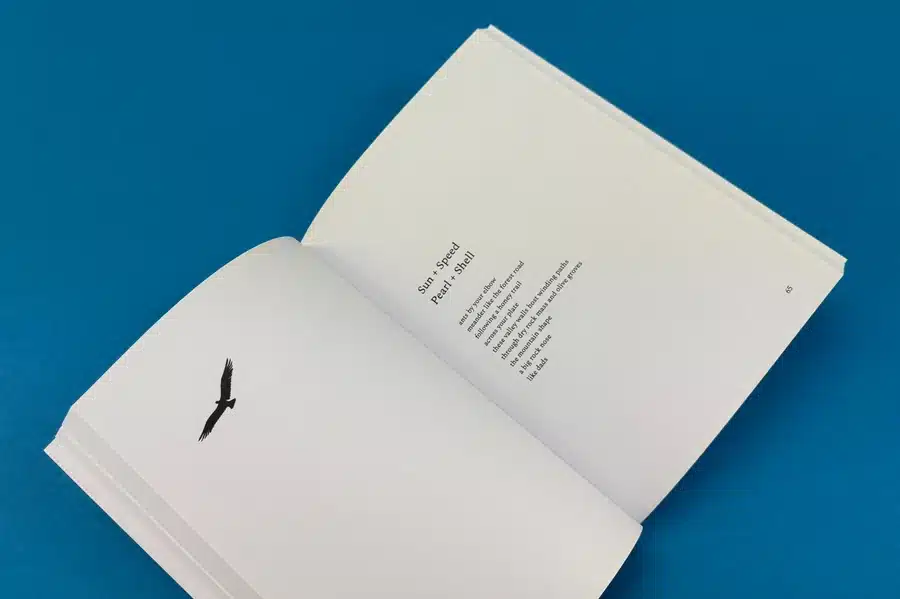
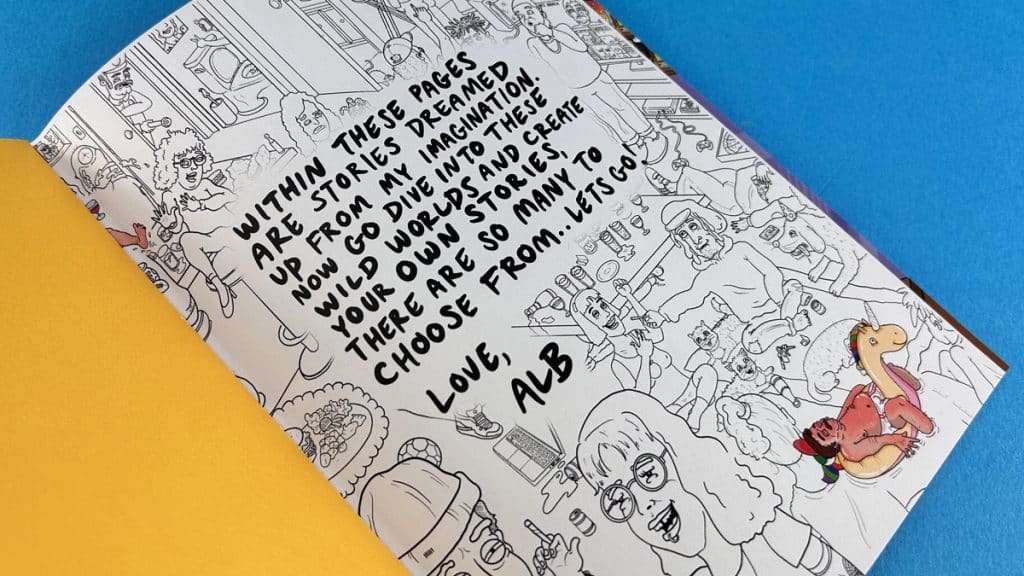
Now that you're familiar with a poetry zine, let's delve deeper into how to craft a concept for your zine. Remember, there's no definitive one-size-fits-all when creating your zine. The beauty of a zine lies in its uniqueness. So, don’t just attempt to mimic existing work; unleash your creativity and weave a story that defines you.
Creating a poetry zine involves battling the storm in your mind. Brainstorming techniques like Stream of Consciousness, Mind Mapping, and Word Clouds can generate ideas. Stream of Consciousness lets ideas flow freely without judgment. Mind Mapping involves visualising related concepts around a central theme. Word Clouds visually map out potential topics by adding related words to a central theme word.
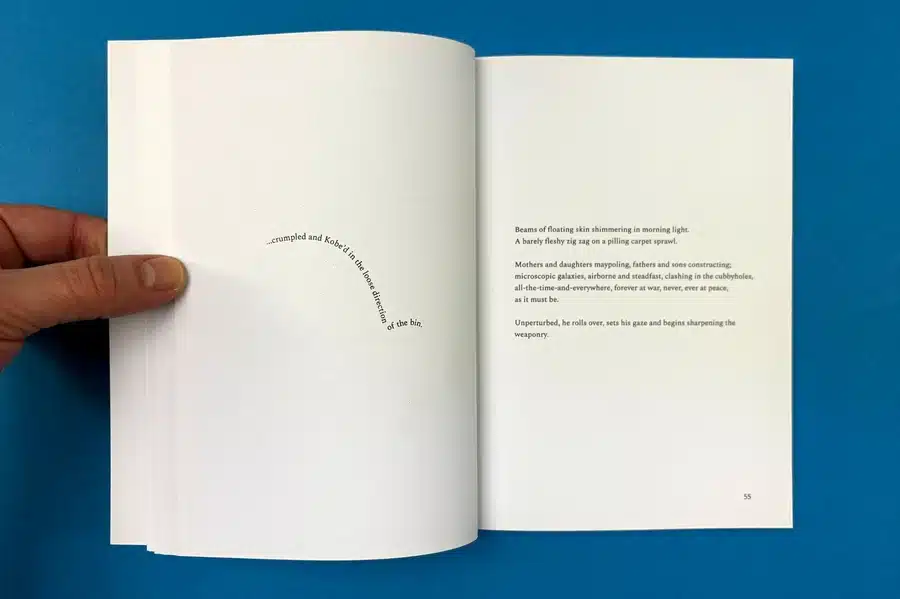
Ideas multiply like rabbits. Immerse yourself in zines to spark inspiration. Explore platforms for layout ideas. Life experiences, values, and beliefs can inspire you in this vast internet culture. From conversations to travel diaries, poetry is everywhere—you just need to find it in the mundane.
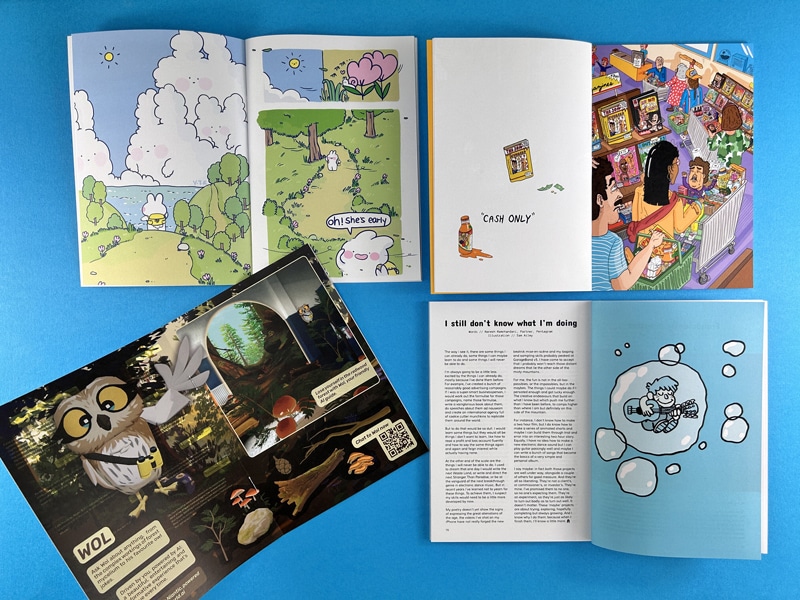
Now that you have a reservoir of ideas, it's time for the next exciting phase - designing your poetry zine. The design process involves two primary elements: visual layout and typography. Each element carries its weight and is crucial in how the final zine appears. After all, the cover of your zine is your first chance to lure the readers into the world of words enclosed within.
The layout of your zine sets the tone for your poetry, guiding the reader through your thoughts and feelings. Visual elements can enhance specific pieces and create a sensory experience. Colors and textures can echo moods, while images and patterns, including collages, add depth to each page, forming unique narratives. Use brainstorming techniques to gather visual content, bringing your mood board to life within your zines.
While the visuals catch your reader's eye, the choice of typography guides them through the pages. A careful selection of fonts not only defines the aesthetic of your zine but also enhances the readability. Choosing the right typeface strengthens the emotion of the words, lending weight to your voice. Variable fonts are great for adding dynamism across the pages of your zine, each waiting to be flipped over to reveal a new page full of surprises. However, remember that legibility should always be prioritised over decorative forms.
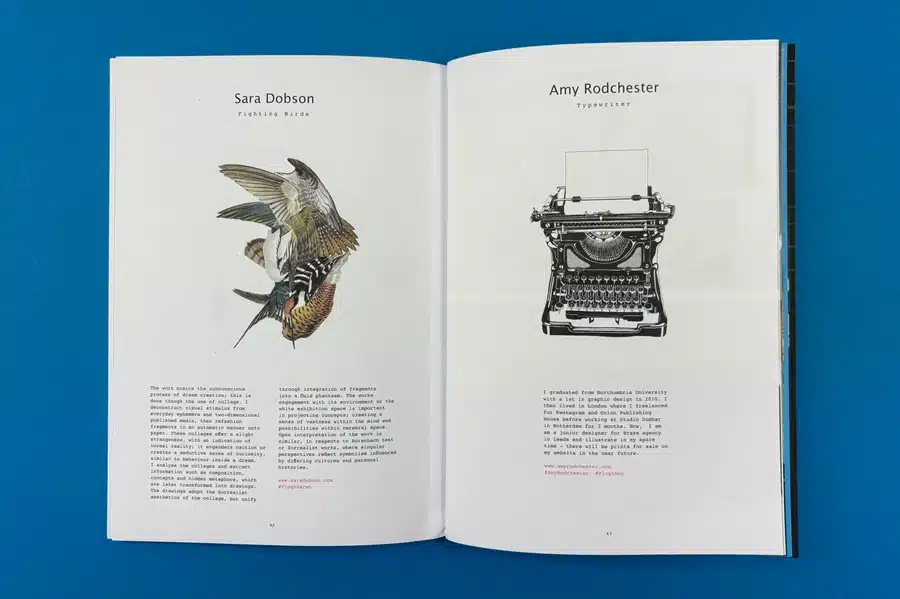
Once the layout and typography of your poetry zine are decided, it's time to select the special verses that you want to share with the world. The process involves picking up your best poems and determining their order in the zine to ensure a harmonious flow.
Selecting poems for your zine calls for intuition and thought. Pick poems that align with your zine's theme and illustrations. Include poems like haikus, sonnets, and free verse to showcase your literary style. Aim for a diverse yet cohesive collection where each poem amplifies your zine's voice. Let every page reflect your poetic essence!
Every zine is a journey guided by you, the arranger. Organising poems thematically adds depth, creating an immersive experience for readers. Arrange poems sequentially to tell a story or based on contrasts/similarities. Each poem should complement the next for a seamless flow of emotions and thoughts on your zine's pages.
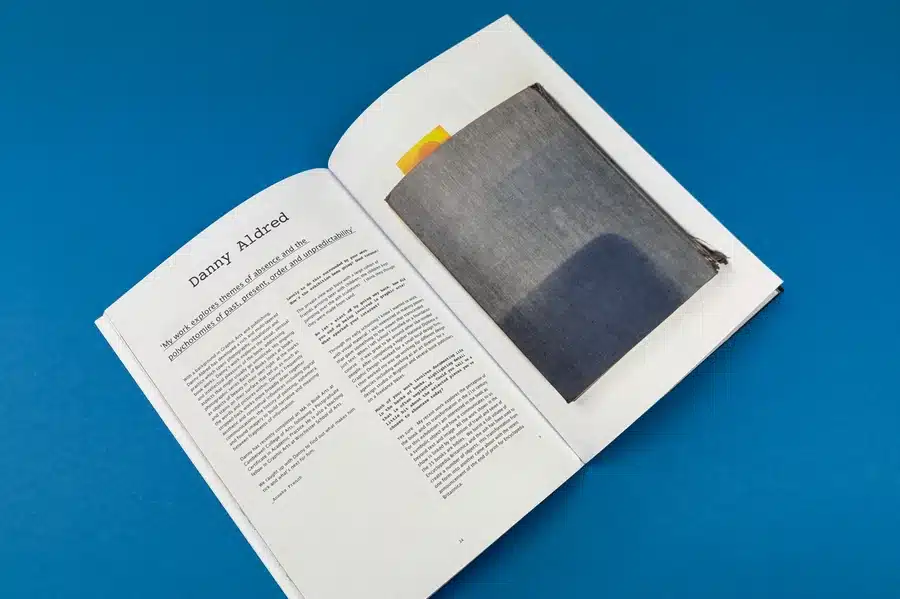
Now that the design and organisation are set, it's time to bring your zine to life. This phase involves decisions on printing, folding, and binding techniques, particularly regarding the content of your zine. It's crucial as it turns your selected words into a tangible piece of art - the poetry zine.
When printing your poetry zine, consider these options: Home Printer: Convenient but limited to A4 size. Costs can increase based on ink and paper type. Photocopier: Ideal for bulk quantities, cost-effective per copy, but requires manual assembly. Online Printers: Offers various sizes, paper types, and binding choices. More expensive for small quantities. Choose a printing option that suits your budget, output needs, and convenience.
After printing, binding your zine is an exciting task that affects its feel and appearance. Contrary to common belief, binding shouldn't be complex or professional-looking. The most common and affordable method is saddle stitching or stapling along the crease of the fold. For a fancier option, consider Japanese or Coptic stitching, which may require extra tools and skills. A regular 'half-fold' style is the simplest and most popular choice for folding.
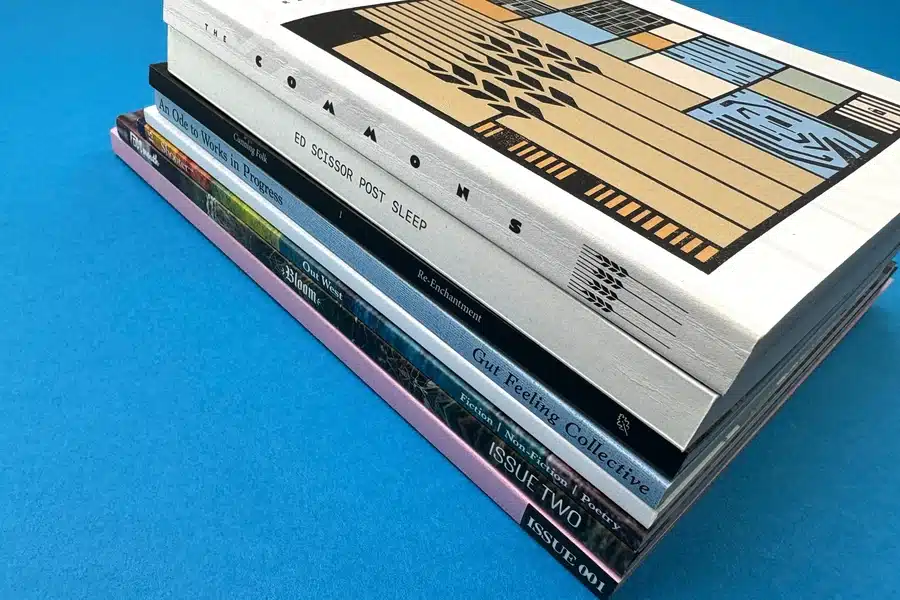
Social media platforms are essential for promoting creative work. Key platforms for promoting your poetry zine include Instagram, where you can showcase your zine visually; Facebook for discussions, live readings, and workshops; and Twitter for engaging with literary conversations and sharing excerpts. Use relevant hashtags to boost visibility and engage with your audience to cultivate avid readers.
Offline promotion is crucial for promoting your poetry zine. Partnering with local bookstores and participating in literature events can help you reach a wider audience interested in literature. Engage with like-minded individuals, receive feedback, and be part of a supportive literary community.
Ready to make your poetry zine stand out? Partner with Ex Why Zed today and bring your creative vision to life!
If you are seriously dedicated to proliferating your zines, self-publishing platforms are a brilliant avenue. With multiple print-on-demand services available now, self-publishing your zine can help you reach a global audience without investing exorbitantly upfront. From selecting the paper quality and typeface to deciding the selling price, you have complete control over how your zine is presented and sold.
Ex Why Zed empowers poets and creators through beautifully printed indie poetry zines. We offer expert guidance from design to print, ensuring each project reflects the creator's vision. With diverse printing options and collaborations with platforms like Popshot, we cater to new and established artists. Explore our services and kickstart your self-publishing journey today. Contact us at hello@exwhyzed.com or call +44 1206 766647 for inquiries or to order your paper sample pack.
Creating a poetry zine is not just about compiling poems; it is a creative endeavour that allows you to express your deepest emotions and thoughts. Crafting a poetry zine involves much more than just writing - from conceptualising themes to designing layouts, each step offers a unique learning experience and a sense of fulfilment. By embarking on this journey, you can establish a profound connection with your readers as you share your inner poet. Embrace your creativity, let your imagination run wild, and begin the exciting process of creating your very first poetry zine today!
If the Forest Could Speak, It Would Look Like This
Charlotte Bellamy’s If The Woods Whispered is a poetic-photographic symphony, where design, print, and emotion converge. With 150gsm uncoated pages echoing the natural world and a silk-laminated cover that softens the visuals, this 180-page piece showcases how material choices can deepen narrative tone. The collaboration nailed every detail—right down to spine width. Designers take note: let content breathe, proof meticulously, and always match your materials to the mood. This project is a blueprint in turning artful intent into a tactile, emotionally resonant book. Read the full story.
A Love Letter to the Unfinished
An Ode to Works in Progress celebrates imperfection with clarity and care. Gut Feeling Collective’s debut poetry book combines a monochrome aesthetic with silk-stock tactility and a bold, minimalist cover. Every element—from justified inner text to a precisely aligned spine—serves the evolving narrative. When last-minute tweaks came in, Ex Why Zed adapted with ease, ensuring the book stayed true to its message. For self-publishers: simplicity isn’t basic—it’s bold. Spine cohesion, tactile finish, and design restraint are your allies. Discover the full case study.
Small Format, Big Impact
Buoy Press’s Poetry Will Have To Do proves that compact design can carry emotional weight. At just 180x100mm, this collection feels intimate—like a secret passed between hands. Printed entirely in black on 100gsm Evolution Uncoated, with a tactile 300gsm cover, the book pairs eco-conscious material with thoughtful layout. Perfect binding enhances durability, while carefully chosen typography lets the words breathe. The seamless reprint process highlights how strong client-printer rapport leads to flawless execution. For indie poets: size can be a statement, and uncoated stocks deliver unmatched warmth. Explore the full Buoy Press journey.
How to Self-Publish a Poetry Book—The Smart Way
This guide distills everything a modern poet needs to self-publish with impact—from shaping your manuscript to designing a standout cover and choosing the right format. It dives deep into practicalities like editing costs, ISBNs, and print options (POD vs. offset), while delivering pro-level insights: use uncoated paper for warmth, don’t cram poems onto pages, and treat your layout like a stage for each piece. Ideal for first-timers and seasoned poets alike, it’s a blueprint for building a book that looks and feels as powerful as your words.
Your No-Fuss Guide to Poetry in Print
Forget the gatekeepers—this hands-on guide empowers you to turn raw poems into a bound poetry zine that’s bursting with personality. From idea-storming and mood boards to layout finesse and bold binding choices, it shows how to shape your style into something tangible. Top takeaways? Keep typography readable but expressive, give poems room to breathe, and match your binding to your vibe. Whether you're printing a one-off zine for a poetry night or scaling up with POD, this is creative freedom at its finest.
Creating a digital poetry zine follows the same process as creating a paper zine, except the output is digital. You design, arrange, and edit your zine using software like Microsoft Word or Adobe InDesign, and then you share the finished digital file online.
Absolutely! Many poets sell their zines either online or at local events and bookstores. Remember to factor in printing and delivery costs when deciding on a selling price.
Inspiration can be found everywhere—books, music, nature, conversations, personal experiences and emotions. You can also explore existing zines on social media platforms like Instagram or online communities.

An action-packed and informative 5 minute read.
Skateboarding isn’t just a sport—it’s a lifestyle, a creative movement, and a thriving subculture. At its core lies a rich tapestry of self-expression, storytelling, and artistry, all of which can be captured beautifully through print. From gritty street scenes to high-flying tricks and the personalities behind them, skate zines and art books serve as lasting tributes to the skateboarding community. Whether you’re looking to create a Perfect Bound Skate Zine, a Stapled Skate Zine, or a Hardback Skateboard Art Book, print is the perfect medium to immortalise the energy, stories, and visuals of skateboarding.
At Ex Why Zed, we’ve had the privilege of collaborating with some of the most innovative creators in the skateboarding world. Through our expertise, we help turn bold ideas into stunning physical publications, each one tailored to reflect the individuality of the project. To help you make informed choices about skate zine printing and skate art books, we’ve analysed and dissected a series of recent printing projects. These case studies showcase the variety of materials, formats, and finishes available, offering insight and inspiration for your next creative endeavour.
Dive into these success stories and discover how thoughtful design and expert printing bring skateboarding’s vibrant culture to life.
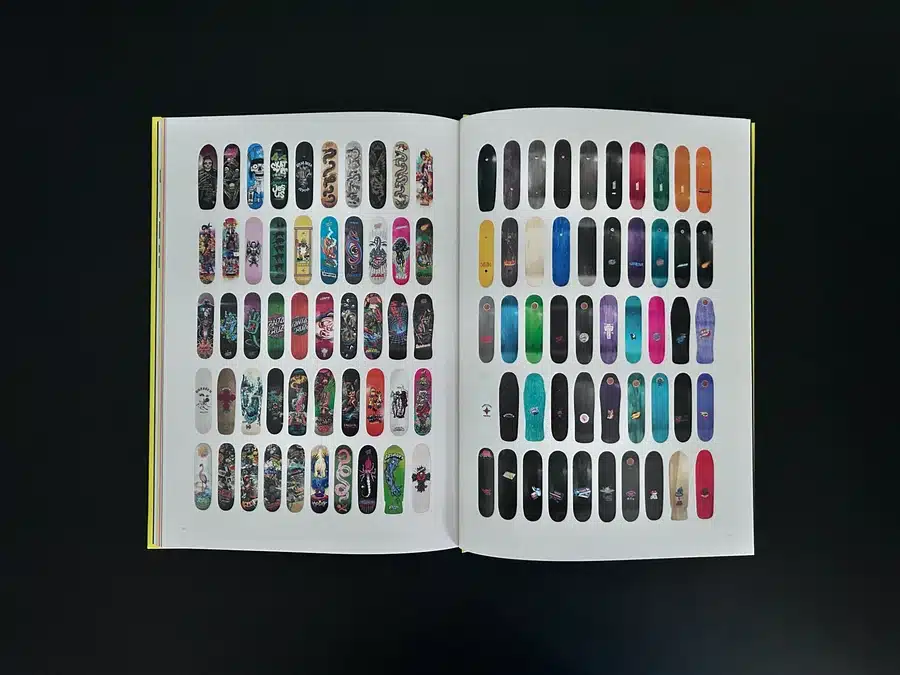
Julio Cesar Battistelli’s hardback art book is a feast for the senses. Featuring a matt laminated cover with Spot UV varnish and Colorplan Ebony endpapers, the design reflects the bold and underground spirit of skateboarding. Inside, the silk paper pages chronicle Yaia’s evolution as an artist, blending gritty monochrome sketches with bursts of colour. This Hardback Skateboard Art Book exemplifies how material and finish choices enhance storytelling.
Key takeaway: Pair tactile elements like Spot UV and silk paper with bold design to capture the spirit of skateboarding art.
Enjoy Yaia's skateboard art book case study >

Chris Emery’s Perfect Bound Skate Zine blends immersive visuals with high-gloss lamination to create a magazine that feels substantial and dynamic. The use of full-bleed photography and high-contrast layouts makes this project leap off the page. Printed on 170gsm gloss paper, it’s a tactile celebration of urban subculture.
Key takeaway: Full-bleed imagery and contrasting colour palettes create a rhythm and narrative that engage the reader.
Enjoy the full skate zine case study >

Dominic Marley’s Hardback Skateboard Art Book is a minimalist masterpiece. With anti-scuff laminated covers and FSC-certified silk paper, this project balances bold cover typography with timeless black-and-white photography. The full-page spreads highlight the energy of skateboarding while the thoughtful layout provides space for each shot to breathe.
Key takeaway: A minimalist design paired with premium materials creates a timeless tribute to skateboarding culture.
Enjoy the full skate art book case study >
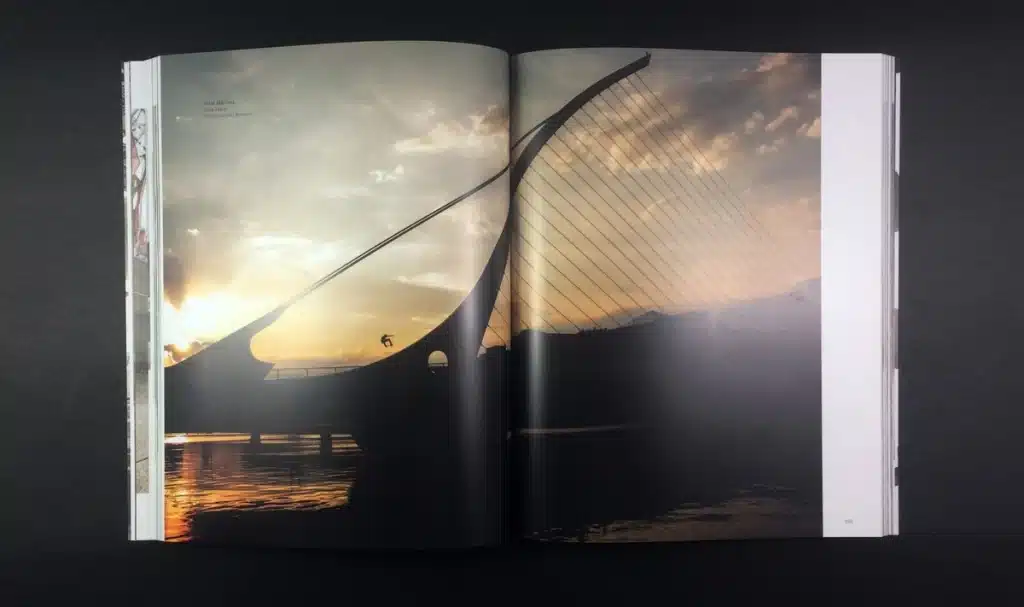
These bi-annual Perfect Bound Skate Zines encapsulate skateboarding culture in a tactile format. Both editions feature 350gsm Silk covers with matt lamination and 170gsm Silk pages, allowing vivid full-colour imagery to shine. Designed to bring online issues into physical form, these publications prove that the power of print is unmatched in creating a lasting impression.
Key takeaway: Repurposing digital content into a tactile publication makes it more personal and enduring.
Enjoy the full skateboard magazine case study >
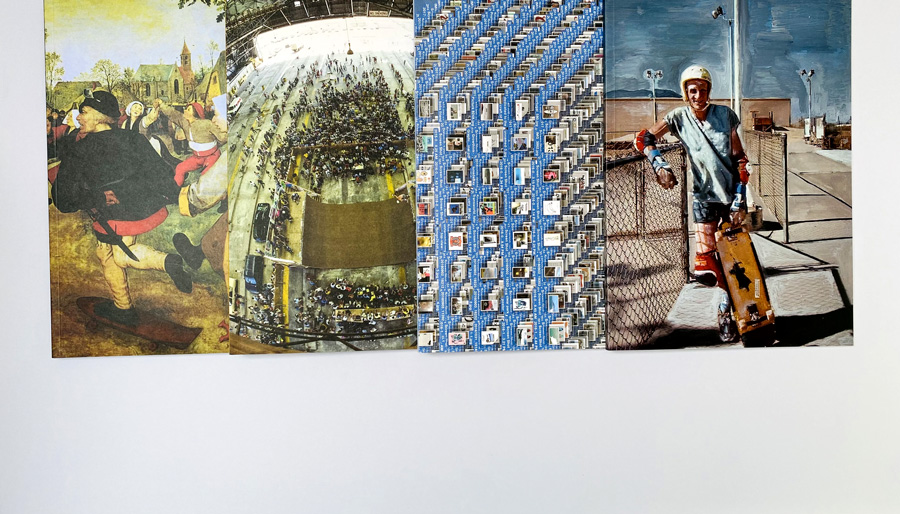
This retro-inspired series honours the DIY skate zine printing ethos of the 1980s. With uncoated paper and a muted colour palette, these Stapled Skate Zines evoke nostalgia while capturing modern skateboarding narratives. The contributors’ blend of photography, letters, and artwork creates a dynamic, multi-layered experience.
Key takeaway: Uncoated stock and DIY-inspired design amplify authenticity in niche skate zines.
Enjoy the full skate zine printing case study >

This collaboration between Lost Art and Nike epitomises raw creativity. The A4 Stapled Skate Zine, printed in black and white on uncoated stock, resonates with the underground energy of skateboarding. The tactile simplicity underscores the rebellious spirit of the culture.
Key takeaway: Black-and-white printing on uncoated stock emphasises grit and authenticity.
Enjoy the full skate zine printing case study >
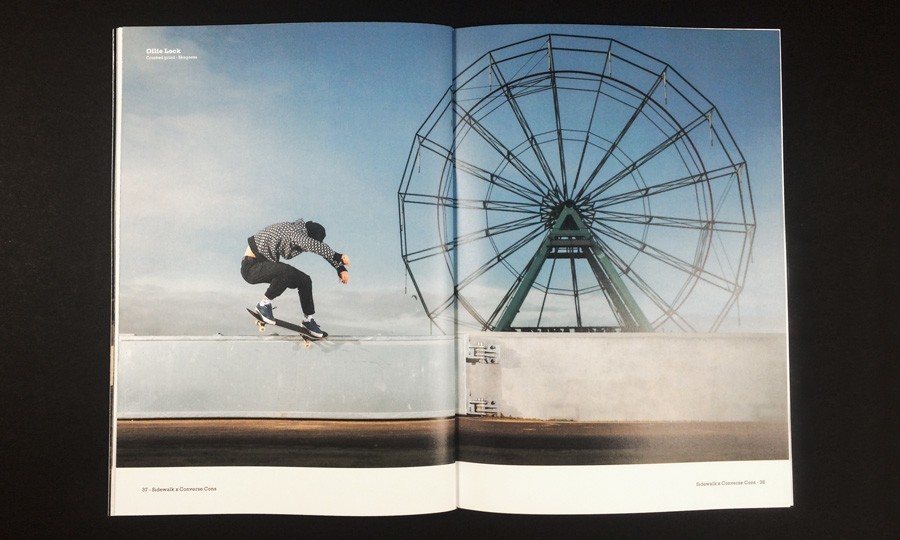
A standout example of concertina postcard printing, "Lobster Tales" blends a perforated postcard set with a complementary zine. Printed on 280gsm Chromocard with a gloss front and uncoated reverse, the postcards create a tactile and interactive experience. Paired with an A5 zine and a sustainable kraft belly band, the project celebrates skateboarding in a playful, multi-format package.
Key takeaway: Experimenting with formats like concertina folds and perforation adds layers of engagement to printed materials.
Enjoy the full skate zine printing case study >

This series bridges the gap between Skate Zines and Art Books. Issue 1’s Perfect Bound Skate Zine format showcases dynamic photography across 150gsm Silk pages, while Issue 2’s Case Bound format elevates it to a premium collector’s piece. The consistent 250x200mm size offers a unique, manageable format for skate photography.
Key takeaway: Adapting a consistent format while experimenting with binding methods builds brand identity across a series.
Enjoy the full skate periodical printing case study >
Skate zines and art books are more than publications—they’re artefacts of skateboarding culture. At Ex Why Zed, we specialise in creating these artefacts with unmatched quality and care. Here’s why we’re the go-to choice:
🌟Accessible, Expert, Friendly Advice. If you haven't done this before, don't worry, we have!
👩💻 Free File Check and Preflight. We aim for perfection and will let you know if anything needs changing.
💃🏻 We Talk the Talk, But We Also Walk the Walk. ⏰ Replies in minutes from print experts, not days or weeks.
🌲 All Papers are FSC Certified. Sustainable printing guaranteed and we also use vegetable inks for litho jobs.
🚀 Fast Turnaround. Booklet delivery in 3 working days. Perfect bound books delivered in 4 and hardback books delivered in 6.
🏆 Finest Digital and Litho Print. HP Indigo and Heidelberg Litho - the best possible quality for short, medium and long print runs.
🖨️ Professional Printing process. Best industry practice, not a mickey mouse website where you throw JPGs at the screen then keep your fingers crossed.
🛠️ Flexible Custom Options. The answer is "Yes", now what is the question?
🖼️ Enjoy 500 Case Studies in our Portfolio. Not made-up CGI nonsense like the other sites have 🤣
😍 A Solution For Every Budget. We always quote for a range of quantities to help hit your target price.🎁 FREE Paper Samples. Make the best possible choice from our extensive print options.
🌍 FREE UK Delivery. Your print will arrive by tracked courier, the day after it leaves us.
🌍 Worldwide Shipping at cost price from a network of couriers.
✅ Transforming Your Ideas Into Print Since 2006.
Start a conversation with us today on hello@exwhyzed.com or 01206 766647.
Whether you’re creating a niche skate zine, a collaborative art book, or a collector’s edition, Ex Why Zed is here to help you make your vision a reality. Our commitment to quality, sustainability, and creativity ensures your project stands out.
Explore our portfolio or get in touch to start your skate zine printing journey. Together, let’s create something extraordinary.
Contact us today and discover why Ex Why Zed is the number one choice for Skate Zine Printing in the UK.
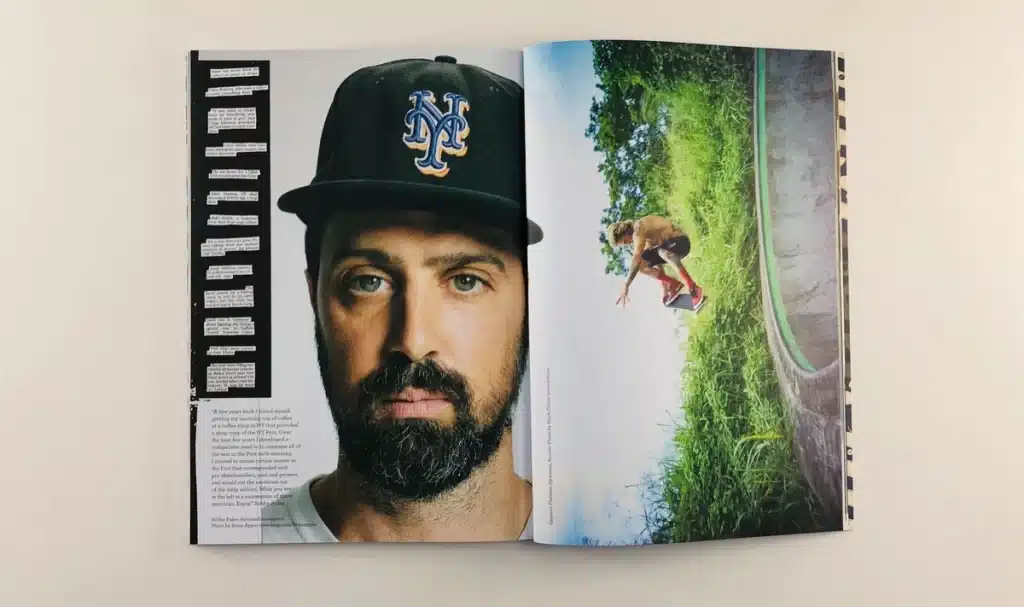
Zines have always been a platform for self-expression, a space where creators can let their imagination run wild. Whether it's a literary magazine like Shooter, a typographic marvel like No Cold Callers, or a poetry zine, each one is a unique piece of art. In this post, we'll take a closer look at these three distinct types of zines, each showcasing a different facet of creativity and individuality.
Shooter literary magazine is a testament to the diversity of topics that can be explored in zines. Each issue is centred around a different theme, providing a platform for a multitude of voices to be heard. For instance, the 'Cities' issue features neatly arranged text following a grid format, showcasing the poetry and creative writing of various writers. The text is intertwined with full-colour pages, acting as a backdrop to the creative writing.
The Shooter zines are perfect bound, with a neat spine that comfortably accommodates the title and the name of the magazine. This binding style not only gives the zine a professional look but also ensures durability.

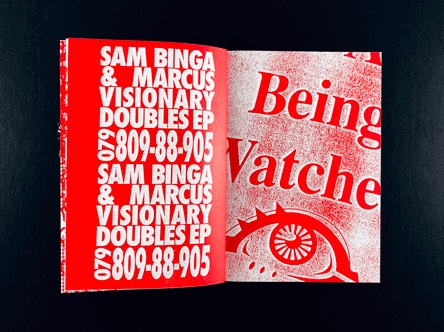
No Cold Callers is a zine that truly embodies the phrase "no rules for zines". It's a typographic feast, with layers upon layers of type stacked over each other. The inside pages are printed on 190gsm paper, showcasing what can be achieved with type.
The zine's design is reminiscent of the iconic work of David Carson and Ray Gun, with its engaging one-colour print and consistent colours per page. The mix of images, photography, and a 70s style typeface creates a visually captivating experience. This compact, A6 wire stitch zine is a testament to the limitless possibilities of zine design.
Poetry zines offer a canvas for expressive words, a space where poets can share their thoughts and emotions. One such zine is an A5 perfect bound zine with 40 inside pages printed onto 90gsm uncoated paper. The cover is a 300gsm silk card with matt lamination on the outside, providing a professional appearance and added durability.
This zine, along with others like it, showcases the unique ways of creating a typographic zine. Each page is designed to attract the reader and grab their attention, with careful consideration given to the size of the font to ensure legibility.

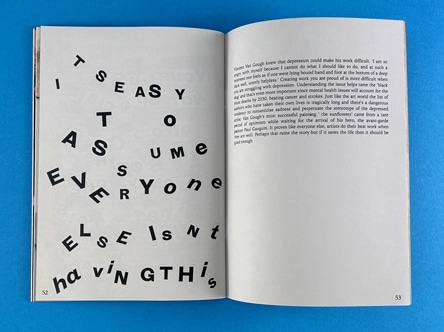
When it comes to styling your typographic zine, there are a few key considerations to keep in mind. The type on each page should be designed to attract the reader and grab their attention. The size of the font plays a crucial role in making your content legible. Check out our Definitive Zine Printing Guide for styling and aesthetic ideas.
For instance, you might want to consider using a larger font size for headers to make them stand out. For body text, a smaller font size would be more appropriate. Splash text, which is used to highlight important information or quotes, can be set in a larger font size and a different typeface to draw attention.
At Ex Why Zed, we are passionate about supporting the vibrant community of independent publishers through our dedicated Indie Press printing services. We've had the privilege of collaborating with innovative creators to bring their unique visions to life. Projects like the evocative works of Buoy Press showcase the power of thoughtful design and quality printing. The insightful Mayday Rooms Pamphlet Series highlights how self-publishing can amplify important voices and ideas. We also crafted the visually stunning Art Journey of Sean Newman, featuring a luxurious linen cover that embodies the essence of his artistic exploration. Additionally, the compelling hardback photography book Bait Gritain demonstrates our commitment to producing high-quality prints that capture the photographer's vision. Each of these projects reflects the creativity and dedication that define the indie press community, and we're honoured to help bring these stories to a wider audience.
By choosing Ex Why Zed for your indie publishing needs, you join a network of passionate creators who value quality, innovation, and personal expression. Our bespoke printing solutions are tailored to meet the unique requirements of each project, ensuring that your work not only stands out but also resonates with readers. Let us help you transform your ideas into beautifully printed realities, just like we did for these remarkable publications.
For more information on zine creation and printing, check out these resources:
Creative writing is a broad field that encompasses various forms, each with its unique characteristics and purposes. The four primary forms of creative writing are:
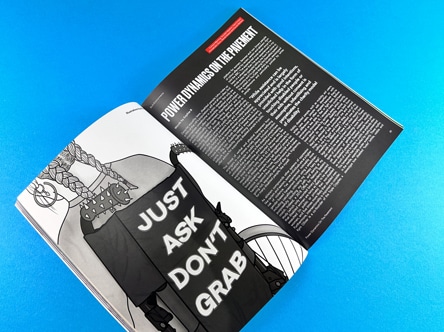
Creative writing is a vast field with numerous types and sub-genres. Here are nine types of creative writing that you might explore:
The five basic forms of creative writing are:
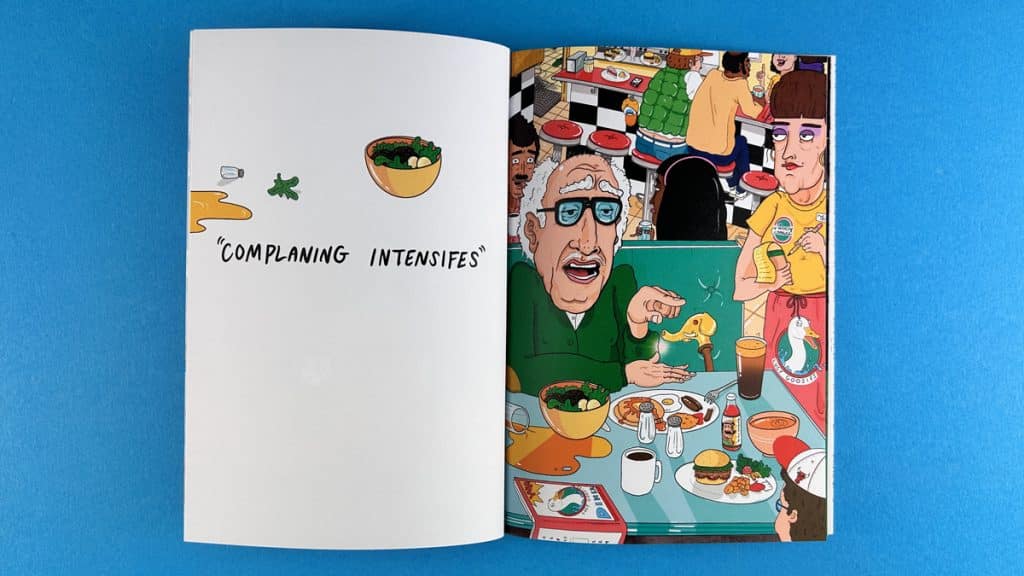
The three key elements of creative writing are:
The seven key elements of creative writing are:
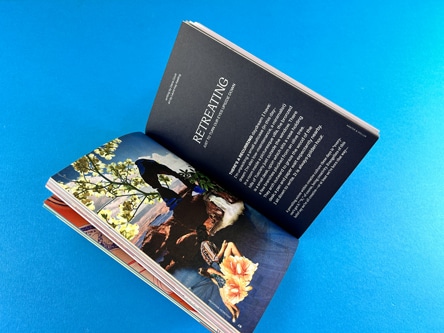
The six traits of creative writing are:
While creative writing is an art form that encourages freedom of expression, there are some general guidelines that can help you improve your craft:

The seven styles of writing are:
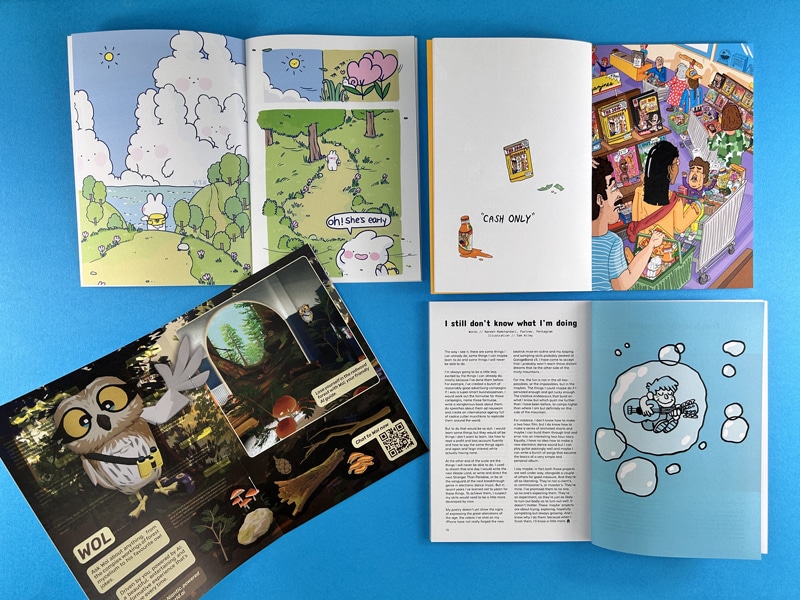
Can you print bespoke sizes? Yes!
Can you send me a sample pack to help choose my papers? Yes!
Is printing black, cheaper than full colour? Yes!
Do you ship to the States? Yes!
Can you print one copy as a test before we go ahead with the final print run? Yes!
Can you print me 38 copies because on your website it only says 50. Yes we can and we’re going to go full on Greta Thunberg with this. If you only need 38 we’ll print you 38 to save some paper. If you need 111 we can print that as well.
Is printing and binding my zine at Ex Why Zed easier than it is on the college photocopier? Yes, but you knew that already right.
When it comes to creating a zine, one of the most crucial aspects to consider is the cover. It's the first thing that your readers will see, and it can significantly impact their first impression of your work. One way to ensure that your zine cover stands out and remains durable is through lamination. In this post, we'll delve into the world of lamination for zine covers, discussing its benefits and the options available to you.

Lamination is a process that involves applying a thin layer of film to the cover of your zine. This film doesn't alter the colour of your printing underneath but serves to protect the fibres of the paper, allowing us to fold it without any issues of cracking. If you've got ink coverage where the sheets are folded, the paper, made of fibres, doesn't like being folded. So when they are folded, if there's ink on that area, the ink and the paper tend to crack. Lamination prevents this, ensuring that your zine cover remains neat and professional. Choosing to go without lamination could result in the cover cracking, which can make it look scruffy and a bit of a mistake. It's especially important to laminate the front cover of your publication if you go for a cover weight of 170gsm or thicker.
You can immediately see cracking on the cover of this wire stitched zine, below. When the cover card has been folded, the ink has cracked and this has opened up the fibres of the sheet to leave a series of scuffed marks down the spine. You shouldn't judge a book by its cover, but when it looks like this....
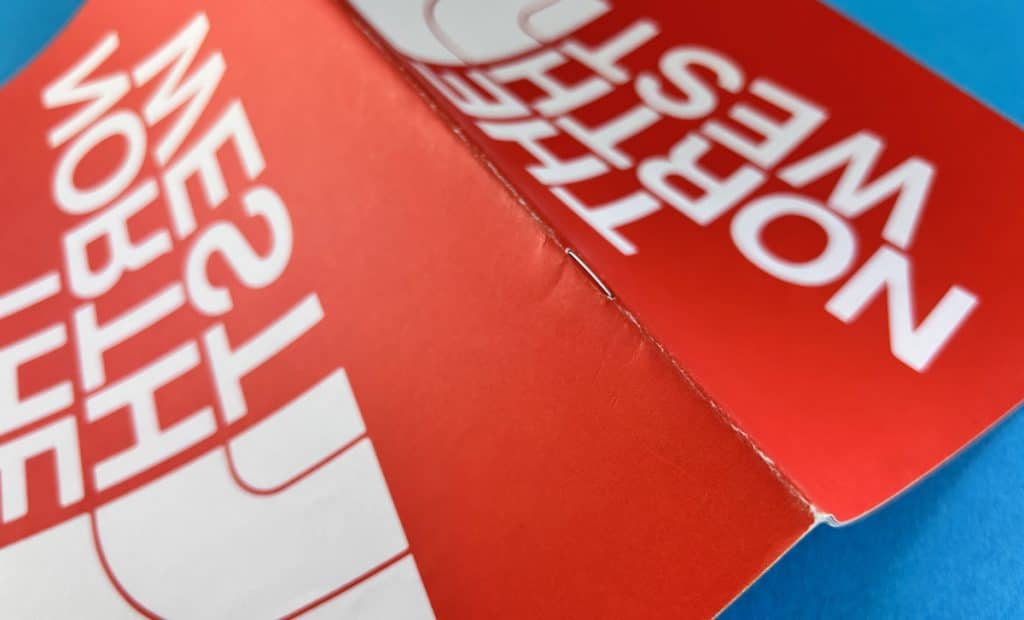
There are four choices for the lamination finish. Each option offers a different aesthetic appeal and texture, allowing you to customise your zine cover to your liking.
Matt Lamination
Matt lamination is the most common type of lamination used for zine covers. It offers a smooth and non-shiny finish, which can give your zine a sophisticated and professional look. Matt lamination is a solid accompaniment for uncoated or silk - not much of a sheen and it just feels professional.
Gloss Lamination
Gloss lamination, on the other hand, provides a shiny and reflective finish. This type of lamination can make your illustrations and colours really jump through, making it an excellent choice for comics or graphic novels.
In the image below we have gloss lamination on 'Able' on the left and matt lamination on Cunning Folk in the foreground. The gloss lamination has more shine and really jumps towards the reader but arguably makes the content harder to see when tilted towards the light. The matt lamination is more subtle and you wouldn't really know it is there.
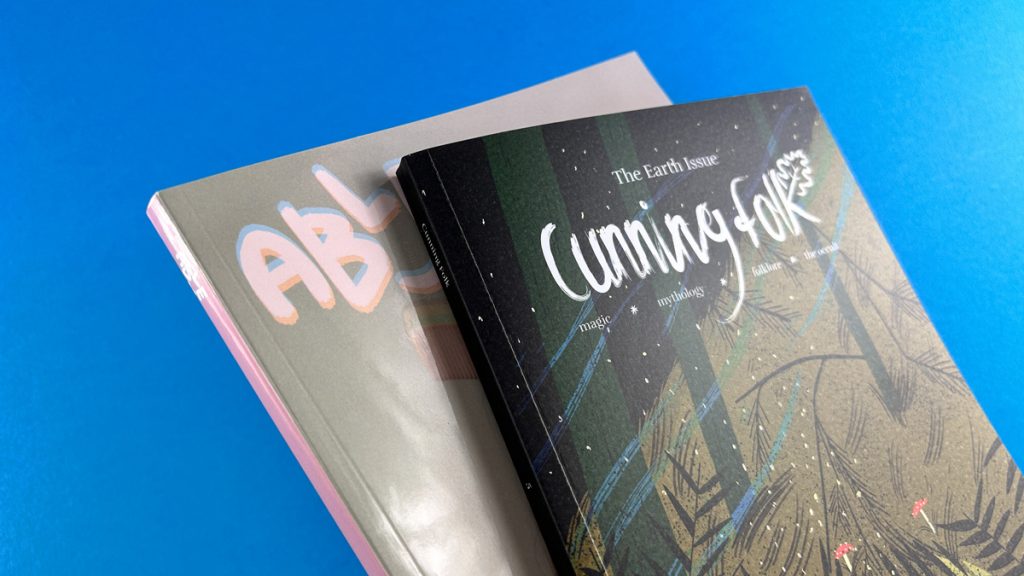
Soft Touch Lamination
Soft touch lamination provides a velvet feel to the cover, offering a unique and professional aesthetic. However, this type of lamination is arguably not suited to zines, as old school Zines would not have even entertained the idea of using Soft Touch lamination.
Anti-Scuff Lamination
Anti-scuff lamination is a less common option, chosen probably once a year. Despite its name, it doesn’t really stop scuffing. It is an option, but we would advisee you to opt for matt lamination instead.
What is the best paper for zine covers?
The best paper for zine covers depends on your personal preference and the aesthetic you're aiming for. However, if you're planning to laminate your cover, we recommend going for a cover weight of 170gsm or thicker.
What is the difference between matt lamination and velvet lamination?
Matte lamination provides a smooth and non-shiny finish, while velvet (or soft touch) lamination gives a soft, velvet-like feel to the cover.
In the photo below, Ephemera has gloss lamination and Cunning Folk is noticeably softer when compared against it.
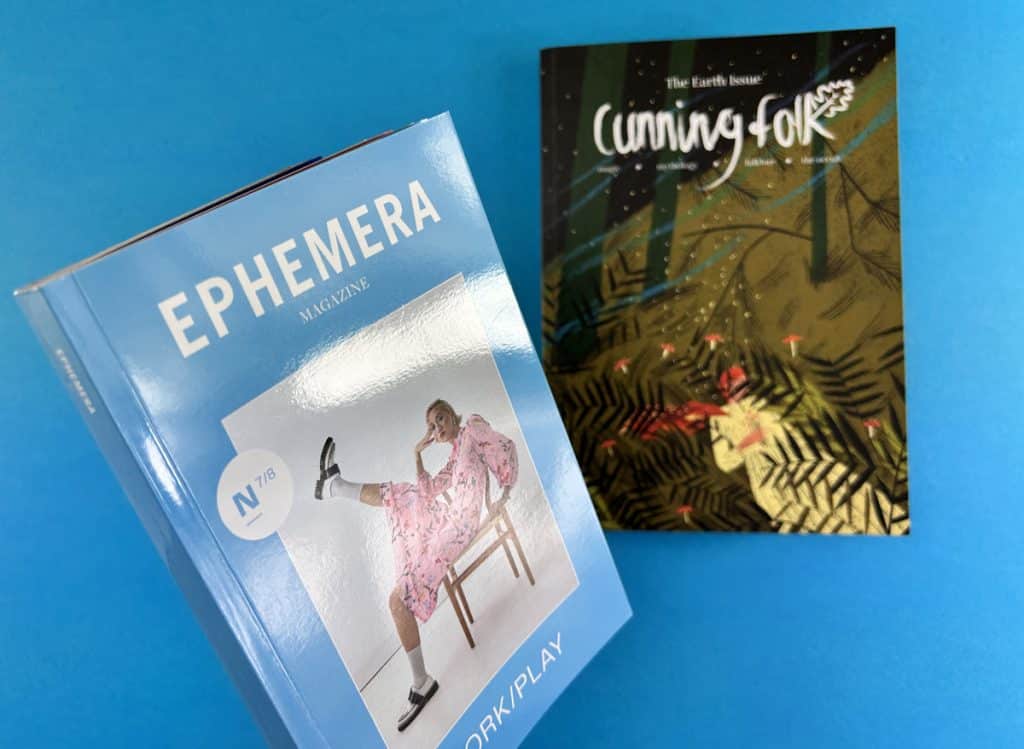
What does lamination do for printing?
Lamination adds a protective layer to the printed material, preventing it from cracking when folded. It also enhances the aesthetic appeal of the printed material, giving it a professional and high-quality finish.
What is velvet lamination?
Velvet lamination, also known as soft touch lamination, provides a soft, velvet-like feel to the cover. It offers a unique and professional aesthetic
When it comes to zine production, the binding method you choose can significantly impact the final product's look and feel. One popular method for binding zines, particularly those with a higher page count, is perfect binding. This method offers a neat, professional finish that can elevate your zine's aesthetic which can command a higher cover price and allow you scope for more content within. In this post, we'll delve into the world of perfect bound zines, exploring the design considerations, binding process, and technical tips you need to know.
Perfect binding is a method commonly used in Bookazine printing and for zines with 36 pages or more. This method involves trimming the inside pages into a text block, roughening up the left-hand edges, applying glue, and then wrapping a continuous cover around the text block. The result is a neat, professional-looking zine with a flat spine.
Perfect binding offers several advantages that make it an appealing choice for zine creators. You've all seen Little White Lies, Shooter and Moof, they are all perfect bound. Firstly, it provides a more high-end, professional look compared to other binding methods. This can be particularly beneficial if you're creating a zine for a professional context or if you're aiming for a more polished aesthetic.
Secondly, perfect binding allows for more illustrations, photography and poetry self-publishing and creative writing to be packed in. While wire stitching is suitable for zines with up to 40 pages, perfect binding can accommodate monster zines with up to 300-400 pages. This makes it an excellent choice for more substantial zines or Bookazines.
Finally, perfect binding creates a neat bind, with less bounce and curling on the inside pages compared to wire stitching. This can enhance the reader's experience, making your zine easier and more enjoyable to read. If your spine is 4mm or thicker there's even room to add your title, issue number and attention grabbing call to action.
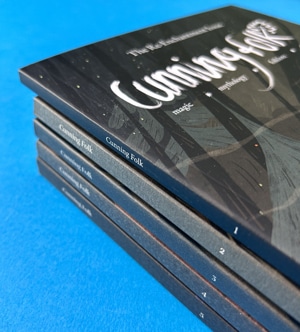
When designing a perfect bound zine, there are several key considerations to keep in mind. One of the most important is the page count. Perfect binding is best suited to zines with a minimum of 36 pages. This ensures that there is enough thickness in the text pages for the glue to hold effectively. Attempting to perfect bind a zine with fewer than 36 pages can result in the pages pulling out, as there is not enough glue to hold them in place.
Another crucial consideration is the cover weight. Because of the amount of glue used in perfect binding, the cover needs to be resilient. We recommend a minimum of 200gsm for the cover. Anything thinner, and the glue may seep through, compromising the binding's effectiveness.
When you come to create your perfect bound zine cover file, check out our dedicated page with super helpful video and illustrated guides plus downloadable InDesign templates to save you some head-scratching.
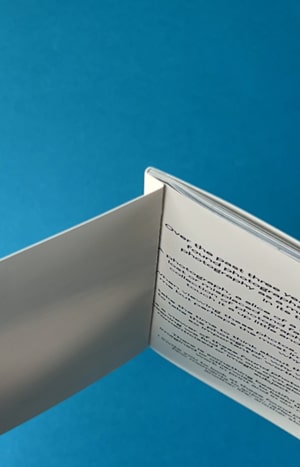
Finally, it's important to allow for a 6-8mm hinge on the front and back cover. This ensures that the cover opens neatly and falls flat again. You'll also need to allow for 6-8mm being lost on the inside front cover and the inside back cover, as well as the first 6-8mm on the spine side of your first and last text page. This area will be obscured by the glue, so it's important to keep any important content at least 10-12mm away from this side of the page.
You can actually see on our example here that the text starts too close to the 6-8mm area and it is very nearly hidden.
Text pages onto 120gsm Uncoated
36pp to 44pp Text = 3mm spine
(ie: if you have 40 pages then you need a 3mm spine)
48pp to 60pp Text = 4mm spine
64pp to 72pp Text = 5mm spine
76pp to 88pp Text = 6mm spine
92pp to 100pp Text = 7mm spine
104pp to 116pp Text = 8mm spine
120pp to 132pp Text = 9mm spine
200pp Text = 14mm spine
Text pages onto 130gsm Silk
36pp to 40pp Text = 2mm spine
44pp to 56pp Text = 3mm spine
60pp to 76pp Text = 4mm spine
80pp to 92pp Text = 5mm spine
96pp to 112pp Text = 6mm spine
116pp to 128pp Text = 7mm spine
200pp Text = 11mm spine

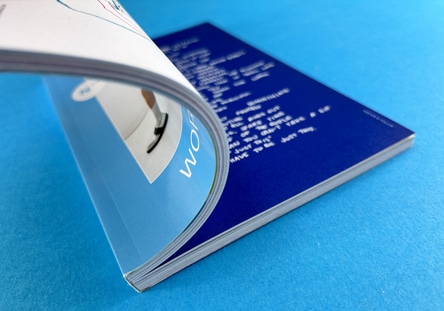
When you come to set up the inside pages, lets keep the key information at least 5mm from the trim edges of the page. On the spine side of the page, 2-3mm tends to be slightly obscured unless the reader really force the pages flat. This isn't a user friendly way to read a book so best to start content on the spine side of the pages at least 8-10mm in. Our image here shows the spine gutter area and you can see the central section is tough to fully read.
This is an example of a superb page layout for a perfect bound book. The text is neatly organised into columns which sit well within the constraints of the page's parameters. The reader does not have to work hard to read the article and it is punctuated with awesome graphics and subtle page numbers in the bottom, outer corners.
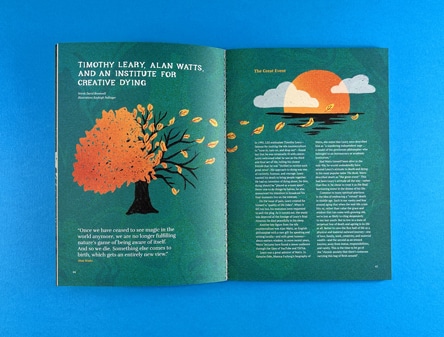
Perfect binding offers a world of possibilities for zine creators. This binding method allows for a wide range of designs and layouts, providing a canvas for your creativity and imagination. Whether you're creating a personal zine or a professional publication, perfect binding can help bring your vision to life.
For more information on perfect binding and other binding options, check out our Perfect Binding Setup Guide and our Binding Options page on our website. These resources provide detailed instructions and illustrated guides to help you prepare your zine for perfect binding.
For a visual guide to perfect bound zines, check out our YouTube videos:
The best binding for a zine depends on several factors, including the page count, the aesthetic you're aiming for, and your budget. Perfect binding is a great option for zines with a higher page count and a more professional aesthetic.
Perfect bound binding is a method that involves trimming the inside pages into a text block, roughening up the left-hand edges, applying glue, and then wrapping a continuous cover around the text block. The result is a neat, professional-looking zine with a flat spine.
You will upload your print ready pdfs to Ex Why Zed. One for the cover spreads and one for the inside pages. We will then give your artwork a preflight check and report back any issues to be ironed out. We strive for perfection in the artwork before we eve consider printing.
When it comes to binding zines, perfect binding emerges as the superior choice. This method bestows your publication with a polished, professional appearance that sets it apart from the rest. It not only accommodates a larger number of pages but also imparts a sturdy bind that stands up to the test of time and use. In contrast to other binding techniques, perfect binding presents a more refined, sophisticated aesthetic, elevating your zine to a higher level of professionalism.
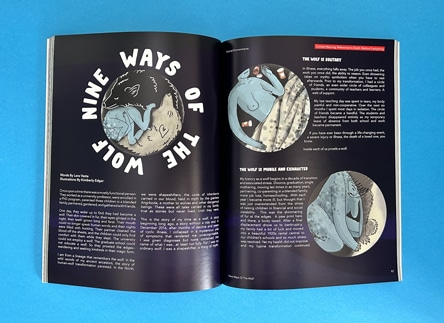
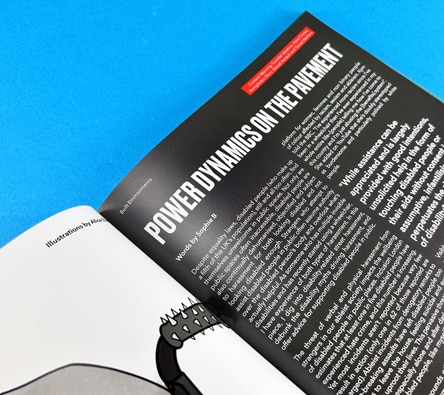
Perfect binding is characterised by its neat, flat spine, its resilience and its professional, high-end appearance. This method is also recognised for its capacity to hold a greater number of pages than alternative binding techniques.
Features of perfect binding include a flat spine, a continuous cover that wraps around the text block, and a 6-8mm hinge on the front and back cover. This binding method also requires a minimum of 40 pages and a cover weight of at least 170gsm.
The two main types of binding for a zine are wire stitching and perfect binding. Wire stitching, also known as stapling, is suitable for zines with up to 40 pages. Perfect binding, on the other hand, is best for zines with a higher page count.
Perfect binding offers a world of possibilities for zine creators, providing a canvas for your creativity and imagination. Whether you're creating a personal zine or a professional publication, perfect binding can help bring your vision to life. With its neat, professional finish and ability to accommodate a higher page count, perfect binding is an excellent choice for your next zine project.
For more information on perfect binding and other zine printing options, don't hesitate to contact us at Ex Why Zed. We're always here to help you bring your creative projects to life.